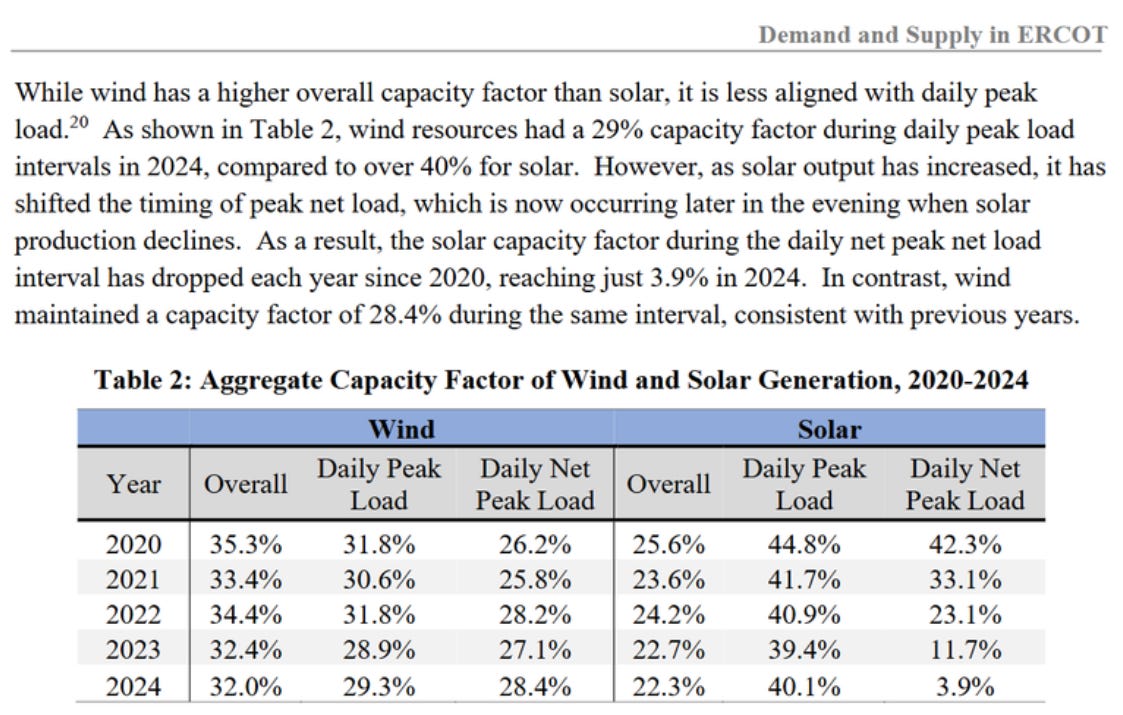ERCOT Lessons - What Not To Do
The Solar Paradox: How More Renewable Energy Can Make Electricity More Expensive
This is wild. When solar first hit the Texas grid, it was a game-changer. By 2020, it was covering 42% of demand during net peak load - a huge win for clean energy. But here’s the twist: the more solar ERCOT1 added, the later the peak demand shifted, creeping into the evening when the sun dips and panels stop producing.
Fast forward to today: Solar generation is now five times higher, yet it covers just 4% of net peak demand. And in winter? New solar capacity might as well not exist when Texas need it most.
The Hidden Cost of Overbuilding Solar
Here’s the kicker: Every new solar panel now makes electricity more expensive.2 Why? Because solar floods the market with cheap power when ERCOT doesn’t need it, undercutting the economics of dispatchable generation (think gas, nuclear, etc.). These plants still have to cover their fixed costs, but now they have fewer profitable hours to do it. So what happens? They raise prices during the remaining critical windows.
The numbers don’t lie: 50% of ERCOT’s electricity costs now occur in just 14% of the time.3
The Death of Solar’s ELCC
There’s a metric called Effective Load Carrying Capacity (ELCC), which measures how much a generator actually helps meet peak demand. Solar’s ELCC? Effectively zero at this point. The more ERCOT builds, the less it contributes when it matters.
"But What About Batteries?"
Sure, batteries can help smooth out the chaos - but they don’t solve the fundamental problem. All they do is:
Shift the same unreliable solar energy around (still no winter solution).
Further erode the profitability of dispatchable power, making the remaining hours even more expensive.
Adding batteries to fix solar’s intermittency is like like trying to fix a leaky pipe with duct tape. It doesn’t eliminate the problem, it just makes it slightly less obvious.
The Winter Problem Nobody Wants to Talk About
Solar radiation drops dramatically in winter. So if we build enough solar + batteries to cover summer demand, winter electricity costs would go through the roof. Why? Because dispatchable plants would still need to exist, sitting idle most of the year, just to cover a cloudy week when batteries are drained and solar does nothing.
The Bottom Line
Texas is learning the hard way that intermittent renewables don’t scale like dispatchable power. More solar isn’t just hitting diminishing returns, it’s actively making the grid less reliable and more expensive.
So am I missing something here?4 Because if not, it’s time for Colorado to rethink how we balance our energy mix before we end up with a system that costs twice as much.5
Electric Reliability Council of Texas
It costs more to build solar plus gas than to build just gas.
If I am, please enlighten me in the comments
If Colorado keeps solar at ~ 7%, that’s fine. It’s a problem if they grow it significantly.






Why does a peaker plant charge more for electricity than a baseload plant? In many cases the two plants are identical. Because the peaker plant has exactly the same cost as the baseload, but fewer hours in which to recoup that cost.
"Adding batteries to fix solar’s intermittency is like trying to fix a leaky pipe with duct tape."
My thought was it was like drilling another hole in the pipe, so less water would come out the original hole.
And Yep - you are exactly right. AND this problem was predicted and modeled extensively 15 years ago. AND proven experimentally multiple times.
https://neon.energy/Hirth-2013-Market-Value-Renewables-Solar-Wind-Power-Variability-Price.pdf
Yes, 12 years ago this paper came out.
"We find the value of wind power to fall from 110% of the average power price to 50–80% as wind penetration increases from zero to 30% of total electricity consumption. For solar power, similarly low value levels are reached already at 15% penetration. Hence, competitive large-scale renewable deployment will be more difficult to accomplish than as many anticipate."
It literally is just math.
In California we were sold wind+solar because they were "free" and secondarily because they were "zero emissions." At the time I paid $0.13 / kWh. Today the lowest I pay is $0.41 / kWh Tier 1. When I run my CNC mill, lathe and 3D printer for my business, along with AC to keep the shop cool, my rate hops up to $0.51 / kWh Tier 2.